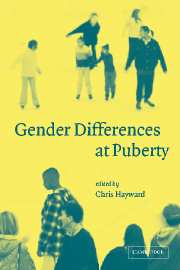Book contents
- Frontmatter
- Contents
- List of figures
- List of tables
- List of contributors
- Preface
- Acknowledgments
- 1 Methodological concerns in puberty-related research
- Part 1 Sex differences in hormones and their effect at puberty
- Part 2 Girls at puberty
- Part 3 Boys at puberty
- Part 4 Puberty and psychopathology
- Part 5 Pubertal timing: antecedents
- 10 Childhood sexual abuse and pubertal timing: implications for long-term psychosocial adjustment
- 11 Psychosocial factors predicting pubertal onset
- Part 6 Pubertal timing: consequences
- Part 7 Puberty and context
- Index
- References
11 - Psychosocial factors predicting pubertal onset
Published online by Cambridge University Press: 22 September 2009
- Frontmatter
- Contents
- List of figures
- List of tables
- List of contributors
- Preface
- Acknowledgments
- 1 Methodological concerns in puberty-related research
- Part 1 Sex differences in hormones and their effect at puberty
- Part 2 Girls at puberty
- Part 3 Boys at puberty
- Part 4 Puberty and psychopathology
- Part 5 Pubertal timing: antecedents
- 10 Childhood sexual abuse and pubertal timing: implications for long-term psychosocial adjustment
- 11 Psychosocial factors predicting pubertal onset
- Part 6 Pubertal timing: consequences
- Part 7 Puberty and context
- Index
- References
Summary
Throughout the past century biopsychosocial models of adolescent development have increased in both their promotion and prevalence (reviewed by Susman, 1997). The biological process of puberty is the typical initiator of the adolescent period of human development (Petersen, 1985). Thus, it is not surprising that the majority of adolescent biopsychosocial research has considered pubertal timing or status (Graber, Petersen, and Brooks-Gunn, 1996) as predictors of social (e.g., Meschke and Silbereisen, 1997; Meschke, et al., 2001) and psychological outcomes (Susman, et al., 1985).
The timing of pubertal onset has potentially negative implications for subsequent psychological and physical health (see chapter 12). Research indicates that early onset of puberty is associated with an increased likelihood of adolescent problem behavior (Caspi and Moffitt, 1991; Steinberg, 1989), depression, anxiety (Brooks-Gunn, 1988; Susman, et al., 1985), and breast cancer in women (Kampert, Whittemore, and Paffenbarger, 1988). The potential health consequences of early reproductive maturation have motivated researchers to investigate the possible predictors of pubertal timing.
Recently, environmental factors have been related to pubertal development (reviewed by Kim, Smith, and Palermiti, 1997). Stress is the environmental factor of interest and has typically been divided into two categories of predictors: physical stressors and psychosocial stressors. Increased physical stressors (e.g., decreased nutritional intake or increased exercise; Brooks-Gunn and Warren, 1985; Frisch, 1983) are more often associated with delayed pubertal timing. Psychosocial stressors (e.g., family conflict or depressed mood; Brooks-Gunn and Warren, 1985; Frisch, 1983; Graber, Brooks-Gunn, and Warren, 1995) are often associated with accelerated pubertal timing.
- Type
- Chapter
- Information
- Gender Differences at Puberty , pp. 217 - 238Publisher: Cambridge University PressPrint publication year: 2003
References
- 6
- Cited by

